150 Years Of French Shipping
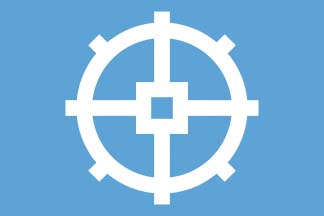 La Rochelle was one of the foremost ports of France during the 14th to 17th centuries, with salt, cognac and wine making the port very wealthy, and merchants building limestone houses that still predominate today in the old quarter of the port. It is known as La Ville Blanche (The White City) and is the capital of the Charente-Maritime region of France, with a hinterland of 25,800 square kilometres. It was also the home port of the large Delmas fleet. The Delmas brothers, Frank and Julien, set up a passenger service from La Rochelle to the Ile de Re and Ile d’Oleron in June 1867 using the very small passenger ferries Jean Guiton and Aufredi. The Alsace region of France was annexed by Germany shortly afterwards, and a third brother Emile (1834-1898), was forced to leave Mulhouse near Basel in the Haut-Rhine region in 1870 and join his brothers. In memory of the province he left behind, the brothers adopted a blue houseflag with the white water mill symbol of eight vanes of the coat of arms of the city of Mulhouse.
La Rochelle was one of the foremost ports of France during the 14th to 17th centuries, with salt, cognac and wine making the port very wealthy, and merchants building limestone houses that still predominate today in the old quarter of the port. It is known as La Ville Blanche (The White City) and is the capital of the Charente-Maritime region of France, with a hinterland of 25,800 square kilometres. It was also the home port of the large Delmas fleet. The Delmas brothers, Frank and Julien, set up a passenger service from La Rochelle to the Ile de Re and Ile d’Oleron in June 1867 using the very small passenger ferries Jean Guiton and Aufredi. The Alsace region of France was annexed by Germany shortly afterwards, and a third brother Emile (1834-1898), was forced to leave Mulhouse near Basel in the Haut-Rhine region in 1870 and join his brothers. In memory of the province he left behind, the brothers adopted a blue houseflag with the white water mill symbol of eight vanes of the coat of arms of the city of Mulhouse.
Delmas Freres et Compagnie then expanded into coal and iron ore shipments, with the first cargo ship of any size being Alsace-Lorraine of 832 grt completed in 1873. She struck rocks and sank off the Chausee de Sein on 18th April 1878, with the next two cargo ships also lost in Belfort 741/77, wrecked on Guernsey on 30th August 1886, and Le Creusot 811/78 wrecked at Bilbao on 25th November 1883. Le Creusot was named after the town in the Saone et Loire department of Bourgogne in Eastern France with many iron ore mines, and other Delmas ships were named after regions near La Rochelle e.g. Aunis, Saintonge, and Poitou. The early steamers traded with coal from South Wales ports to French ports returning with pit props and charcoal, or iron ore from Bilbao.
The brothers also set up manufacturing plants in the 1880s decade for compressing coal dust into industrial briquettes and pellets for use as fuel, and took over the management of five small steamers employed in that trade. New steamers of around 2,000 dwt to 2,500 dwt came from the North Sands yard of John Blumer at Sunderland in 1881/83 as Aquitaine, Biscaye, Guyenne, Saintonge and Vercingtroix. Second hand steamers were purchased from Newcastle upon Tyne, Glasgow and Liverpool shipowners e.g. Sestao renamed Aunis in 1879 but later wrecked on Antioch in Turkey on 13th August 1898.
A fleet of six steamers was maintained during the 1890s decade, with Dahra and Sahel purchased from De Freitas & Company of Hamburg in 1896, but sold on in 1901 and replaced that year by Dahra (2) of 3,000 dwt, the former Liverpool owned Casos, and Sahel (2) of 3,000 dwt, the former Foyle owned by the Mercantile Steamship Co. Ltd. of London. Baron Elibank 2,356/89 was purchased in 1899 from Hogarth of Glasgow and renamed Fort-Louis but was lost by collision on 28th May 1910.
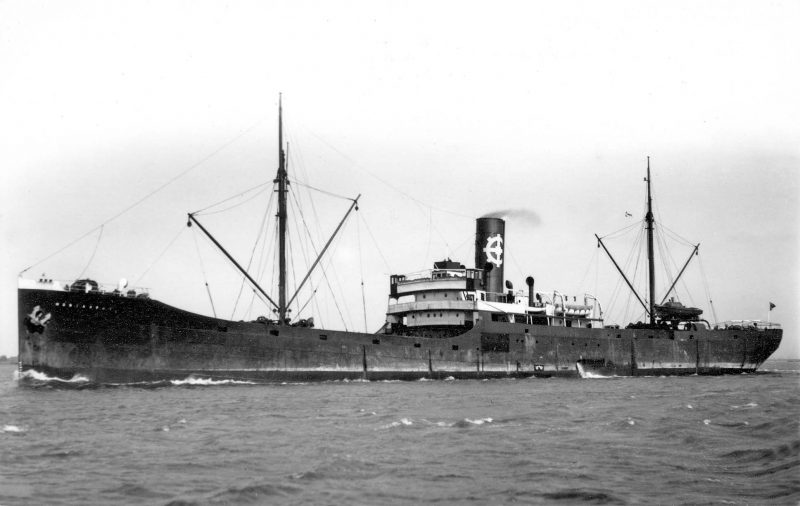
The important Algerian trade began in 1896, followed by that to Tunisia and Morocco, with Delmas shipping phosphates from Tunisia and ores and minerals from Algeria and Morocco to their processing plants at La Rochelle. The first steamer to be named after a member of the Delmas family was purchased in 1911 and renamed Frank Delmas of 2,365 grt, having been completed at the South Shields yard of John Readhead & Sons Ltd. in March 1904 as Tregarthen for Hain Line. Koordistan had been purchased from Strick Line in 1906 and renamed Maroc, and two former Newcastle upon Tyne steamers were purchased in 1912 and renamed as Corneille ex Newquay of J. & C. Forster, and La Fontaine ex Lady Tennant of Scott Brothers. Voltaire of 2,659 grt was also purchased in 1912 from a French owner, but had been completed in February 1896 by the Readhead yard as Birnam for Doughty & Company of West Hartlepool. These bigger steamers had ‘midships bridge decks of length eighty feet, an overall length of just over 300 feet, beam of 44 feet, and depth of 22 feet, with triple expansion steam engines from North East Coast engineers giving service speeds of around ten knots.
A fleet of ten steamers of up to 4,500 dwt was owned on the outbreak of the Great War on 3rd August 1914 in Boileau, Corneille, Dahra (2), Frank Delmas, Gafsa, La Fontaine, Maroc, Moliere, Sahel (2) and Voltaire. Three quarters of the fleet was lost during the war to enemy action, including Boileau which went missing on a voyage from Swansea to St. Nazaire with coal on 10th November 1915. Dahra (2) was torpedoed and sunk off Arzew by U38 on 4th November, 1915, with three more ships lost in 1918 in Maroc in the English Channel on 14th April, and Voltaire off Cape Ortegal on 11th January. Leon had been purchased in 1917 from a French owner but was torpedoed and sunk by UC75 in the English Channel on 7th January 1918. Two small wooden American war standard vessels built at Oakland and San Pedro in California joined the fleet temporarily at the end of the war as Hadrumete and Utique.
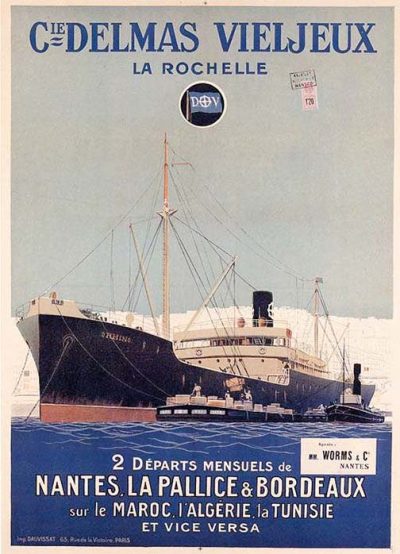 Inter-War Years & World War II
Inter-War Years & World War II
Leonce Vieljeux (1865-1944) had served as a young man at La Rochelle with the 123rd Infantry Regiment, and had met and married Helene Delmas, the daughter of Frank Delmas, in 1890. He joined the family company in 1898 and became a director of Compagnie Delmas Freres in 1920, and brought a new stimulus to the company in the post-war era. He was later appointed President of the company, which was renamed Compagnie Delmas-Vieljeux in 1935. He was elected Mayor of La Rochelle in 1930 and re-elected five years later. After France was overrun by Germany in June 1940 and the establishment of Vichy France, he refused to display their propaganda and was dismissed and expelled from La Rochelle later in 1940. He came back secretly to the city in 1941 and helped to organise the French Resistance network in the grounds of the company headquarters. He was arrested in 1944 and shot in the concentration camp of Struthof, and two of his nephews, Frank Delmas and Yann Roullet, plus Joseph Camaret, the General Manager of the Delmas-Vieljeux repair shipyard established in 1922 at La Rochelle, were also shot for their patriotism to France.
New steamers rebuilt the fleet from 1920 onwards, including the turbine powered Cevennes of 3,800 dwt from a yard at Nantes, and the engines ‘midships sisters Argonne and Auvergne of 3,200 dwt from the J. Samuel White yard at East Cowes on the Isle of Wight during a lull in warship construction. War reparations included the former Woermann Line steamer Waregga 3,830/14 renamed as Medea, the former Austro-Hungarian steamer Marechal Foch 2,369/05 kept her name after purchase, the Oldenburg Portuguese Line steamer Arucas of 3,500 dwt became Emile Delmas, and the standard vessels War Fish 2,646/17 and War Power 2,948/18 were renamed Monique Vieljeux and Tristan Vieljeux.
The important West African trade was begun in 1920 with plantations created in the forests of the Ivory Coast for the export of valuable logs, timber and palm kernels, in addition to the exotic and expensive okoume wood from Gabon. Argonne of 1920 loaded the first cargo of okoume from Gabon shortly after she was completed, and the trade in logs began to rapidly increase. The bigger sisters Kairouan and Medjerda of 6,850 dwt were completed as the coal carriers Capitaine Rodier and Capitaine Charles Boivin in 1923 for the French Government at the Bordeaux and Harfleur yards of Forges et Chantiers de la Gironde. They were purchased by Delmas-Vieljeux on 19th July 1924, and strengthened and converted to carry logs with heavy lift derricks added by the La Pallice yard of Delmas-Vieljeux. Rhin was wrecked on 8th October 1924 during a gale at Pointe de la Coubre to the south of La Pallice while on a voyage from Bona to La Pallice with ore. The fleet numbered fourteen steamers in 1925, and the twin masted four hold steamer Andre Thome of 3,100 dwt was purchased in May 1927, she had been launched as a standard ship on 15th June 1920 by the Arsenal de Brest.
In 1929, seventeen steamers of up to 6,980 dwt were taken over from Compagnie du Chemin de Fer Paris-Orleans to continue importing English and Welsh steam coal for the French railways. These steamers were Agen, Albi, Angouleme, Aurillac, Blois, Bourges, Chateauroux, Lorient, Montauban, Nantes, Poitiers, Psyche, Saint-Nazaire, Saumur, Stilbe, Tours, and Vendome. During the Depression, several ships were laid up, and some of these colliers were diverted to tramping to the United States and Canada, returning with grain to France. A fleet of thirty steamers was owned in 1933, with two more registered under the Societe Lorraine de Combustibles, but several ships were sold off during that year with two sold to Chandris of Greece and renamed Mari Chandris and Keti Chandris.
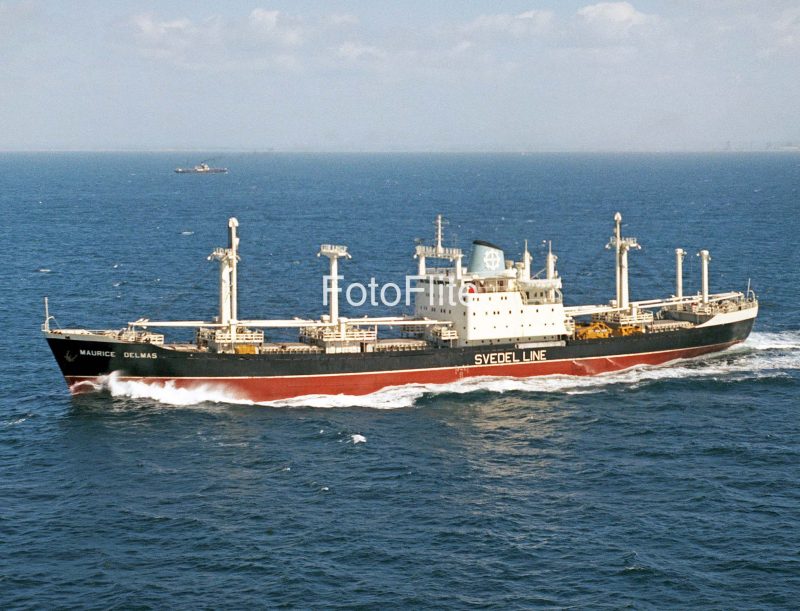
Kairouan was wrecked at Cape Juby in Rio de Oro (Spanish Sahara) at 0330 hours on 3rd November 1934 in mist while on a voyage from Casablanca to Libreville in ballast. Capt. Carpier, nine officers and 27 crewmen abandoned the ship the following day, as all efforts to refloat the ship had failed, and were repatriated to France via Las Palmas. When freight rates improved in 1936, Mecanicien Principal Carvin of 6,745 dwt, one of a series of nine sisters built in 1920/22 as war replacements for the French Government, came under Delmas-Vieljeux management, and continued trading to West Africa for Compagnie Commerciale de l’Afrique Equatoriale Francaise. Two further steamers were purchased in 1938 and renamed Maurice Delmas of 4,785 dwt and Cornouaille of 5,105 dwt from Compagnie Maritime Belge (CMB).
A fleet of twenty two steamers were owned on the outbreak of war on 3rd September 1939, with two motorships of 7,300 dwt on order at the Penhoet yard at Saint Nazaire. A subsidiary company of Societe Naval Delmas-Vieljeux (SNDV) had just been created, but due to the war it was not until January 1947 that the surviving fleet was registered under this company. Montauban had sailed from the Tyne with coal bound for Marseille on 9th January 1940 but got no further than the Saltscar Rocks at Redcar, where she ran aground and broke up six days later. Maurice Delmas was seized by Italy in December 1942 and renamed Modica. She was bombed and sunk at Naples by Allied aircraft on 15th February 1943, but was raised and repaired in March 1947 and re-entered service for Italian owners as Modica until broken up at Naples in 1960. A total of eight ships were lost by 1944 as the fleet was requisitioned or seized by the British, Vichy French and Italian Governments, with further losses by Allied bombing and submarine activity in the Mediterranean by the end of the war. These included the steamers Albi, Aurillac, Auvergne, Bourges, Chateauroux, Cornouaille, Lorient, Mecanicien Principal Carvin, Medjerda, Poitiers, Saint Nazaire and Saumur.
Post-War Fleet Reconstruction
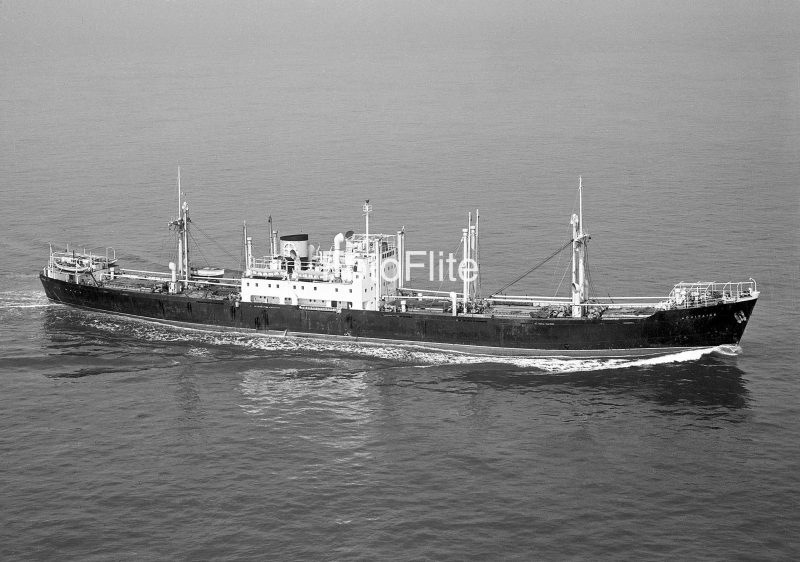
The fleet reconstruction took five years from the end of 1945 until 1950, but a temporary stop gap of two ‘Empire’ types of 10,000 dwt and built in British yards as Empire Falstaff and Empire Stronghold were chartered at the end of the war. They were subsequently purchased in 1948 and renamed as Commandant le Biboul and Colonel Vieljeux respectively. In 1946, four ‘Liberty’ types joined the fleet under management for the French Government and were renamed as La Rochelle, Pallice, Rochefort and Royan, with two further examples later managed as Argentan and Bernieres. In 1947, the first three new ships joined the fleet as Maine of 7,300 dwt from Marine Industries Ltd. at Sorel on the St. Lawrence, Morbihan of 5,550 dwt from the Glasgow yard of Harland & Wolff Ltd., and Aquitaine of 7,060 dwt from the Bartram yard at Sunderland. Cotes du Nord of 7,000 dwt joined the fleet in 1948 from the yard of Canadian Vickers Ltd. at Montreal, with the two cargo-liners ordered in 1939 at Penhoet and launched in 1943 and finally completed in 1949 as Frank Delmas and Joseph Camaret. Four colliers were completed in 1949/50 as Rhuys and Quiberon of 4,750 dwt by the Arsenal de Brest yard, and Armorique and Picardie of 7,194 dwt by the Penhoet yard, the latter pair being managed for S.N.C.F. (French Railways).
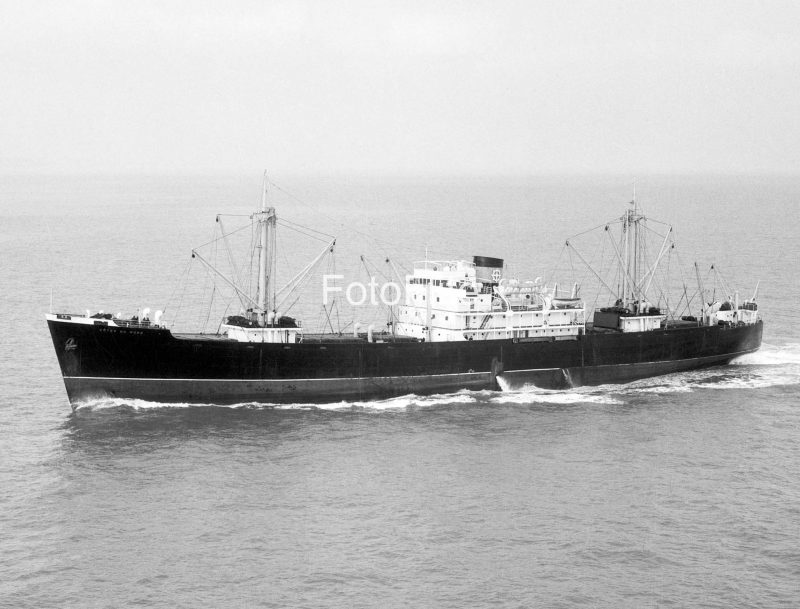
At the end of the reconstruction, the fleet size had been restored to its pre-war level of 22 ships, with 10 ships employed on the important West African trades to the Ivory Coast, four to the Senegal trades of peanuts and wine carried in deep tanks, four to the North African ores, phosphates and minerals, one small tanker carrying crude oil from Senegal, and three deep sea ships on general tramping charters. Ships were also transferred to the coal trades of S.N.C.F. (French Railways) from the main fleet on request. A new line to East Africa, the Indian Ocean and the Red Sea was begun in 1951 as the Svedel Line (SVEde DELmas) in a pool agreement with the Swedish Africa Line to greatly increase the amount of cargo lifted in the African trades with ports served as follows:
West African Line
Hamburg, Bremen, Amsterdam, Rotterdam, Anvers, Dunkirk, Le Havre, Rouen, Cherbourg, Brest, Lorient, Saint Nazaire, Nantes, La Rochelle, La Pallice, Rochefort and Bordeaux to Casablanca, Las Palmas, Port Etienne, Dakar, Kaolack, Lyndiane, Ziguinchor, Conakry, Tabou, Sassandra, Abidjan, Lome, Cotonou, Lagos, Apapa, Burutu, Warri, Port Harcourt, Douala, Kribi, Libreville, Port Gentil, Pointe Noire and Matadi. Branch offices were opened in many of these West African ports.
East African Line (Svedel Line)
Hamburg, Bremen, Antwerp, Rotterdam and French ports to Jeddah, Port Sudan, Massawa, Assab, Djibouti, Aden, Mombasa, Tanga, Dar es Salaam and Port Louis (Mauritius).
The company also managed the veteran steamer Amarante of 2,500 dwt for Societe Navale Guyanne, built in 1922 as Kerkena for Compagnie France Navigation of Marseille, and the new five hold cargo-liner Pierre Eugene de Caplane of 11,150 dwt for Compagnie Commerciale de l’Afrique Equatoriale. The latter ship had been completed in 1950 by the Penhoet yard with a split profile giving two holds forward and two aft with the fifth hold between the bridge and the engineers accommodation. She was sold in 1959 to Nouvelle Compagnie Havraise Peninsulaire (NCHP) and renamed Ville de Manakara and was broken up in 1979 as Rena. A crude oil trade from the Middle East to the Donges refinery in France was also begun in the 1950s by the jointly owned SNDV-Societe Courtage et Transportes, with tankers used such as Iliade of 18,800 dwt and Phenix of 21,060 dwt. A veteran cargo-liner was purchased in 1957 for £280,000 in a former four masted Norddeutscher Lloyd ship built back in 1915 as Remschied. She was renamed Saintes by SNDV but was sold for scrap two years later in 1959 and made the long one way voyage to Japan under the name of Kinokuni Maru.
Expansion In The 1960s And 1970s
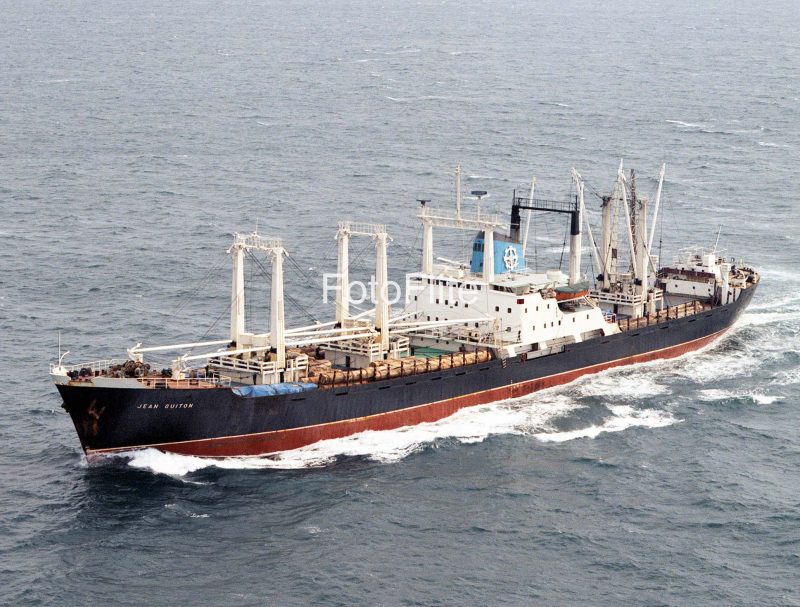
In 1961, Tristan Vieljeux replaced his father Pierre Vieljeux as Chairman of the company, with Christian Vieljeux, Patrice Vieljeux and Maurice Delmas also as directors of SNDV. The way forward was to strengthen the East African and West African trades with new cargo-liners of 9,000 dwt similar to Jean Guiton and Leonce Vieljeux completed in 1958. These were completed in 1963/64 by the Bartram yard at Sunderland and the Port de Bouc yard in Provence as Maurice Delmas and Henri Delmas of 10,900 dwt. Maurice Delmas had three holds forward of the superstructure and two aft, with derricks on three masts and three sets of posts including heavy lifts on the foremast and mizzen mast. She was a replacement for Maine of 1947, which was lost when she ran aground three miles west of Tabou in the Ivory Coast on 8th October 1963 while on a voyage from Libreville to Dakar with logs and timber.
The S.N.C.F. (French Railways) coal trade decreased with the advent of diesel locomotives, and this staple trade ended in 1965. Engines aft log carriers were ordered for SNDV with Eldonia Delmas of 19,142 dwt in service in 1963, two more purchased in 1968 and renamed Louis Delmas ex Rocroi of 16,434 dwt and Julien Delmas ex Oppelia of 18,770 dwt, and sisters Bertrand Delmas and Emmanuel Delmas of 15,740 dwt in service from Japanese yards in 1971.
The centenary of the company in 1967 celebrated a record turnover of 442 million francs, with five thousand people employed as shore staff and seafarers, and in the repair shipyards at La Rochelle and La Pallice, and in fuel and financial subsidiaries. An agreement with the Danish shipowner Petersen of Copenhagen had just been signed to form the Franco-Danish Shipping Company using the cargo ship Britain of 5,500 dwt. An order for four cargo-liners of 14,600 dwt had been placed with the yard at La Ciotat for delivery in 1967/68 as Helene Delmas, Irma Delmas, Lucie Delmas and Marie Delmas with service speeds of 17.5 knots from Sulzer diesel engines. These were to replace the last of the war built ‘Liberty’ ships and other early post-war vessels.

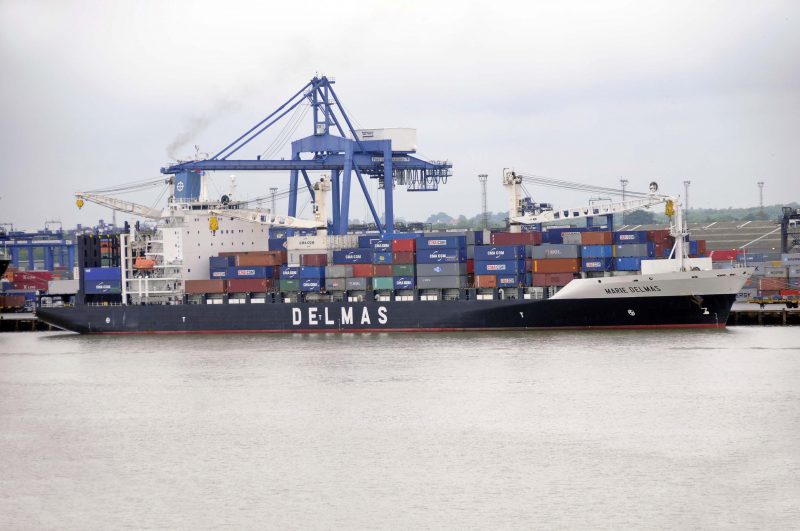
This cargo-liner design of the new quartet culminated in two handsome engines aft classes, firstly a class of eight cargo-liners of 15,750 dwt completed during 1970/74 for the African trades by French yards as Christian Vieljeux, Eric Vieljeux, Francois Vieljeux, Georges Vieljeux, Leonce Vieljeux, Patrick Vieljeux, Pierre Vieljeux and Stephanie Vieljeux. They had three goalpost masts with an array of small and heavy lift derricks to handle logs at African ports and were powered by six cylinder Sulzer diesels of 17,000 bhp to give a service speed of nineteen knots. Secondly, eleven examples of the ‘Marindus’ class of 15,600 dwt were completed by the Marine Industries Ltd. yard at Sorel in Canada in 1975/76 as Calvados, Cantal, Correze, Cotes du Nord, La Pallice, La Rochelle, Poitiers, Rochefort, Royan and Tours.
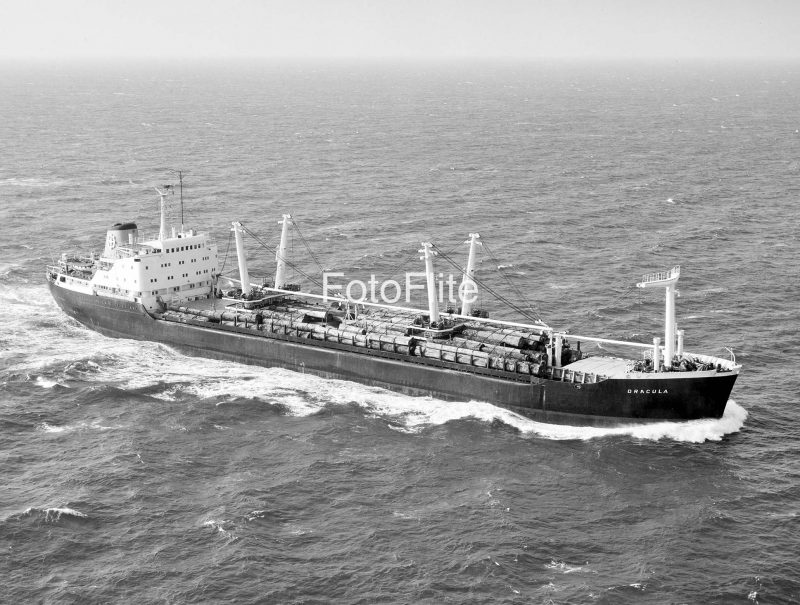
In addition, fourteen cargo-liners were purchased in 1971 from Chargeurs Reunis (United Shippers) of France in Daloa, Daphnis, Dina, Djiba, Douka, Dracula, Loudima, Louga, Loulea, Talassa, Tamba, Tchibanga, Tessa and Tidra following an important full co-operation agreement signed on 22nd October 1970 in the West African trades by Tristan Vieljeux and Francis Fabre of Chargeurs Reunis.
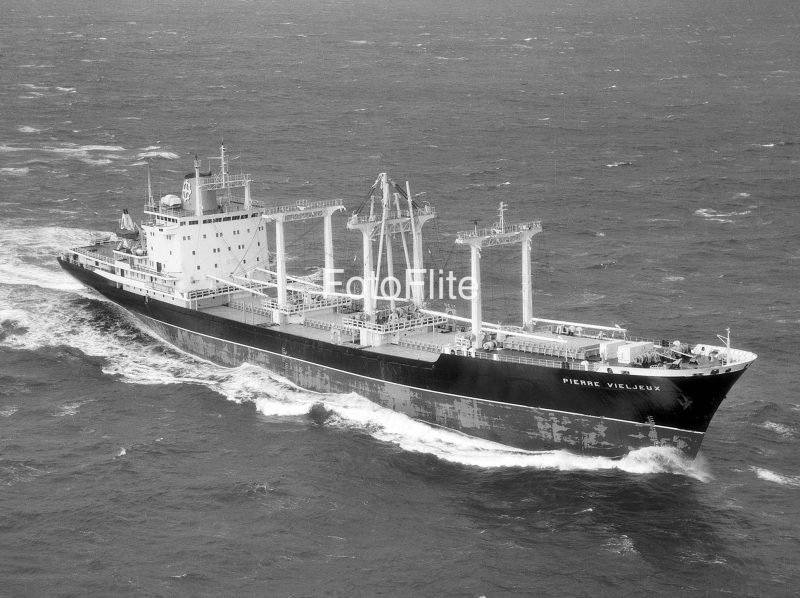
The motorship Francois Vieljeux loaded 6,000 tonnes of copper ingots and cathodes and seven hundred tonnes of zinc at Dar-es-Salaam towards the end of January 1979, before heading for Mombasa to load coffee on top of the metal. The ‘turn out’ for her valuable cargo was 14,000 tonnes, but she ran into heavy weather in the Mediterranean on her way home and water entered numbers 2, 3 and 4 holds through the hatch covers. She took a list to starboard after passing Gibraltar but then ran into the middle of extreme weather and a Force 12 gale in the North Atlantic. The list increased to 22 degrees and she foundered shortly afterwards on 14th February 1979, with her 25 crew and three wives abandoning ship. Unfortun-ately, only nine survivors were picked up from the maelstrom, with one survivor dying later. Twenty lives were lost, and one feels that perhaps she should have put into Gibraltar to repair her hatch covers and correct her list before encountering the full force of the North Atlantic in winter.
The title of the company was changed to Societe Navale Chargeurs Delmas Vieljeux (SNCDV) in 1972, and owned a big fleet of over forty cargo-liners, log carriers and other types of vessel employed in the African trades. Preparations were being made for the advent of partial containerisation in these trades by ordering four con/bulkers from French yards of 24,946 dwt and able to carry 912 TEU of containers with a service speed of twenty knots. These were delivered during 1978 as Helene Delmas, Irma Delmas, Lucie Delmas and Marie Delmas with six cellular container holds, five forward and one aft of the superstructure, served by six electric cranes of 25 tonne capacity with four placed in tandem. A fleet of over thirty vessels was being traded in the late 1970s and included the big log carriers Andre Delmas, Frank Delmas, Lucien Delmas and Michel Delmas of up to 26,500 dwt and delivered from 1976 onwards from Japanese yards with either heavy lift derricks on goalpost masts or pedestal cranes.
Containerisation Of The African Trades
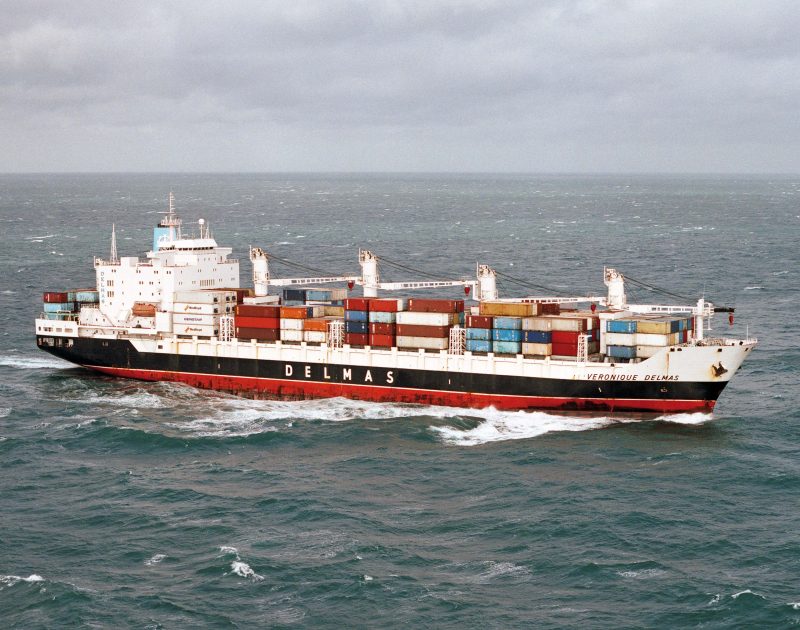
A big fleet of thirty five vessels was being traded by SNCDV in 1980 with eight new container ships on order from Saint Nazaire yards in four of 1,100 TEU capacity and completed as Nathalie Delmas, Patricia Delmas, Renee Delmas and Suzanne Delmas, and four of 1,700 TEU capacity and completed as Therese Delmas, Ursula Delmas, Veronique Delmas and Yolande Delmas. They all had four electric cranes of thirty tonnes capacity for lifting containers on and off in small, poorly equipped African ports. Two coasters were also operating in Senegal and Gabon, the two most active areas of African produce of coffee, peanuts, palm kernels and oil, logs and sawn timber. A quartet of container ships was completed in 1986 by French and Yugoslavian yards as Adeline Delmas, Delphine Delmas, Blandine Delmas and Caroline Delmas of 33,500 dwt and 912 TEU capacity and equipped with five cranes of up to forty tonnes capacity for handling logs. Sixteen new ships had been completed for SNCDV between 1978 and 1986.
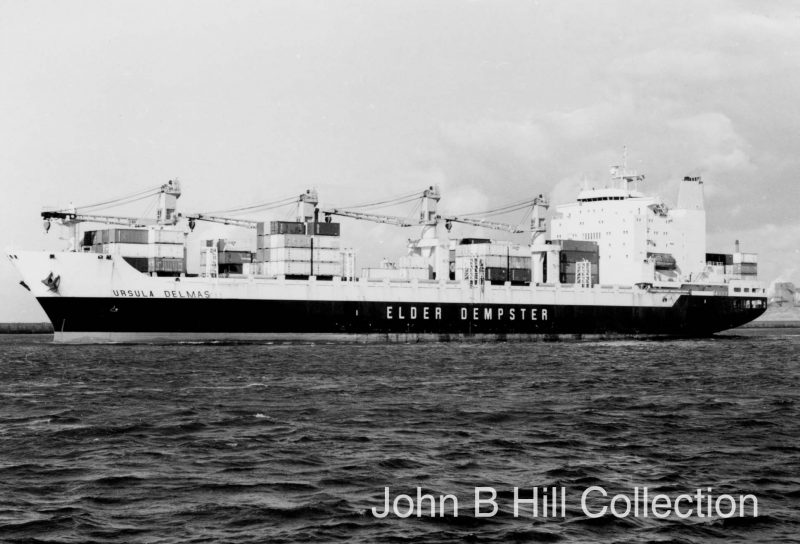
A new service was created in June 1986 from North European and French ports to Reunion, Mauritius and Madagascar in agreement with Novelle Compagnie Havraise Peninsulaire (NCHP). Worms et Compagnie, parent company of NCHP, and Delmas – Vieljeux SNCDV decided to merge and concentrate their combined fleets on the Indian Ocean, Red Sea, Persian Gulf and West African services. SNCDV purchased a two thirds share in NCHP in order to better optimise the resources allocated to the two companies. The ‘Capricorn’ service to the Indian Ocean in 1987 received two SNCDV vessels of 26,300 dwt in Renee Delmas, renamed Ville de Rouen, and Suzanne Delmas, renamed Ville de Marseille.
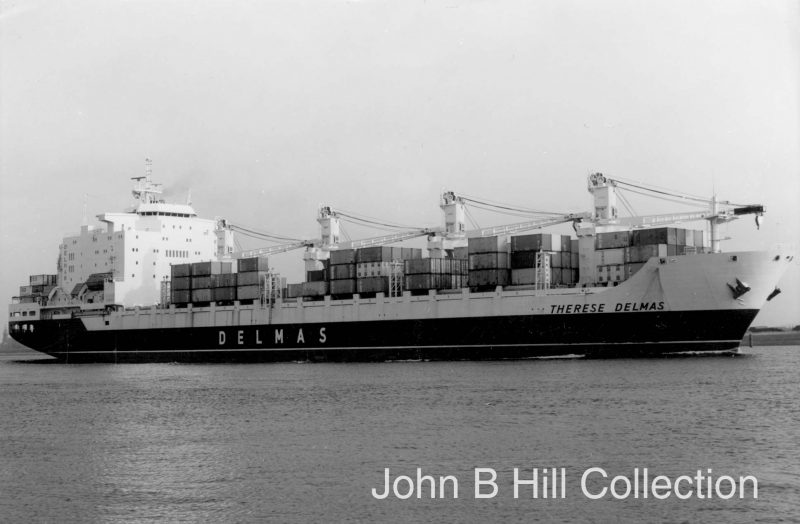
In October 1986, an attempt to purchase their partner company of Chargeurs Reunis in the West African trades by State owned CGM French Line came to nothing as the French Government had a privatisation agenda at that time, and the move was seen as a form of nationalisation. Chargeurs Reunis was then sold in January 1988 to Delmas Vieljeux, one ro-ro named Ango being already one third owned by Delmas Vieljeux. The wording in the SNCDV title was then changed to Societe Navale et Commerciales Delmas Vieljeux.
The former British subsidiaries of Ocean Transport and Trading Ltd. of Palm Line, Elder Dempster and Guinea Gulf Line and all of their trading rights were acquired by SNCDV in 1989. Elder Dempster had been formed to trade to West Africa in 1869, although the first small vessel owned by MacGregor Laird had voyaged from the Mersey to West Africa in 1832. Palm Line had been formed in 1929 as an amalgamation of the United Africa Co. Ltd., associated with the Lever Brothers and the Unilever Group. Guinea Gulf Line was part of John Holt & Co. Ltd. of Liverpool, with sailing ship services to West Africa dating back to 1868. The former Elder Dempster service of the U.K. West Africa Line was then maintained by five Delmas ships of 1,400 TEU capacity.
Also in 1989, ANZDL (Australia New Zealand Direct Line) was purchased by SNCDV, which operated from Australia and New Zealand ports to the West Coast of the U.S.A. and was originally known as Pacific Australia Direct (PAD). PAD had been sold to CGM/Sofrana Unilines in 1987, and three big CGM ro-ros named Rousseau, Rodin and Rostand began to operate on the route. Six vessels with ‘Capitaine’ prefixes to their names were purchased by Delmas Vieljeux from Sofrana Unilines during 1987/89, and the con/bulkers Helene Delmas and Irma Delmas were renamed Direct Falcon and Direct Kiwi. Two container ships were taken on charter for two years from P. & O. and renamed Direct Kookaburra and Direct Kea. The ANZDL service was operating eight owned and chartered ships in December 1998 when it was purchased by Canadian Pacific Ltd. from Delmas Vieljeux and Brierley Investments of New Zealand.
In 1990, Delmas Vieljeux was operating a big fleet of 50 ships, 43 owned and 7 chartered, and was the 18th biggest shipping company in the world. An order was placed at the end of 1990 for three container ships of 2,300 TEU capacity with the ‘3 Maj’ yard in Croatia, but the order was sold on to MSC before the vessels were completed. In 1996, Vincent Bollore and the Bollore Group of France acquired a one third shareholding in the company, triggering an automatic takeover of SNCDV, and it was renamed as SCAC (Societe Chartering and Commission) Delmas Vieljeux. Tristan Vieljeux relinquished family control of the company, although he later returned in 2005 to a seat on the Board of CMA CGM.
A fleet of 35 ro-ros, con/bulkers, container ships and general cargo ships was being traded, including the standard ‘Rostock’ type Georges Delmas of 12,665 dwt purchased in 1994 and equipped with four heavy lift derricks of forty tonnes capacity for handling logs. This size of owned fleet was being traded at the Millennium with eight more container ships on order from Chinese and Korean yards, and two on charter to MSC as MSC Bogota and MSC Jessica. The new container ships were delivered in 2001/02 as five of 2,262 TEU capacity named Catherine Delmas, Marie Delmas, Nicolas Delmas, Julie Delmas and Louis Delmas, and three of 1,645 TEU capacity as Elisa Delmas, Flora Delmas and Nala Delmas. A chartered fleet of a dozen smaller multi-purpose vessels was also traded, distinguished from the owned fleet by having ‘Delmas’ prefixes to their names.
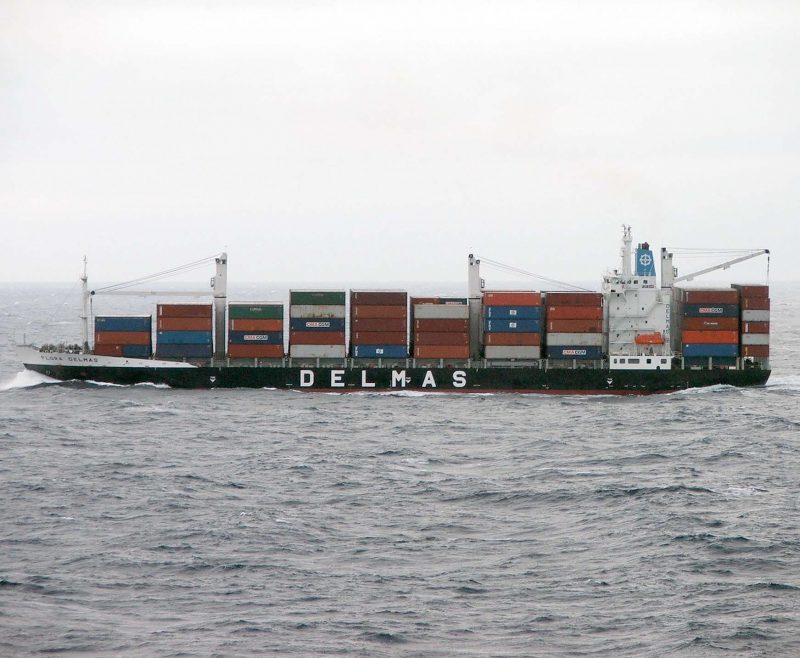
Delmas was acquired from Bollore Group by CMA CGM in September 2005 for 600 million euros, with the transaction taking effect from 5th January 2006. The shipping revenue of Bollore Group was 750 million euros at the time, but this represented only 13% of the total Bollore Group turnover. OT Afrika Line operating the Antrak ro-ro service to West Africa and part of Delmas, was included in the deal with their eight ships named Kamina, Kariba, Kagoro, Kidira, Kintampo, Kribi and Kumasi. The last OT Afrika (U.K.) office was renamed as Delmas (U.K.) in June 2011.
Six large Delmas ro-ros, three of which had been purchased from Hoegh Line, also operated on the West African route with white hulls, although Rosa Delmas, the former Rosa Tucano, had completed a charter to the U.S. Military Sealift Command in 2005. The ro-ros were named Rokia Delmas ex Rosa Blanca, Roland Delmas, Romain Delmas, Rosa Delmas, Roxane Delmas and Saint Roch. Rokia Delmas unfortunately grounded on 24th October 2006 at 0400 hours on the south coast of Ile de Re when she hit a rocky outcrop about one mile from the shore. She was carrying a container cargo of 500 tonnes of cocoa beans and immediately took a thirty degree list to port. The ship had sustained serious damage with a hole twenty metres by one half metre in her bottom, and she proved impossible to re-float by Smit salvors, being broken up several months later ‘in situ’.
Roxane Delmas and Romain Delmas were sold in 2008 to Dannebrog of Denmark and renamed Marienborg and Charlottenborg respectively. Roland Delmas was sold for breaking up at Gadani Beach in June 2010, and Rosa Delmas was sold for breaking up at Aliaga in September 2013. At that time, the fleet of seventeen ships included the two largest ro-ro vessels in Laura Delmas and Lucie Delmas of 35,748 dwt, completed in 1978/79 by the Verolme yard at Rotterdam as Nedlloyd Rochester and Nedlloyd Rotterdam respectively. There was also the CMA CGM feeder container ship Fas Var in the fleet, which was operated separately from that of the big CMA CGM container fleet from the Delmas offices on Quai Colbert in Le Havre. The Delmas fleet retained their distinctive light blue funnel colours proudly displaying the white mill wheel symbol of the coat of arms of Mulhouse. The container ship quartet of Adeline Delmas, Delphine Delmas, Blandine Delmas and Caroline Delmas, dating from 1986 had been sold off in April 2011. An order for three ro-ros with the 16Hyundai Mipo Dockard in South Korea was placed in 2011 to renew the fleet, but the order was subsequently cancelled.
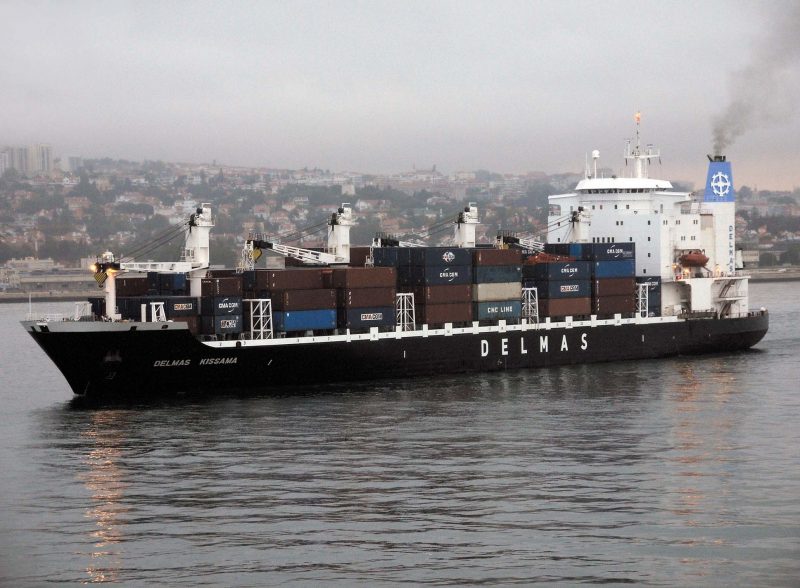
Delmas Services In 2016
A big fleet of twenty Delmas vessels in 2016 operated 25 direct services to 42 countries including Europe to West Africa, East Africa and South Africa, the Far East to West Africa, East Africa and South Africa, and West Africa to South America. The Head Office at Quai Colbert in Le Havre and 58 branch offices in 37 countries employed a total staff of 1,200. Container, ro-ro, break bulk and project cargo including bulky, unwieldy single items were carried on all of these weekly and bi-weekly services. Onward transport to inland African counties was provided to Burkina Fasso, Chad, Guinea Bisseau, Mali, Niger, Sudan, Kenya, Uganda, Rwanda, Burundi, Malawi, Zambia and Zimbabwe. The Noura Express service operated from East Africa to Salalah and the Persian Gulf as part of their Indian Ocean network. The services were augmented with extra vessels temporarily taken from the huge parent company fleet of 450 CMA-CGM vessels.
Obituary
Tristan Vieljeux died on 30th April 2015 aged ninety years, his father was Pierre Vieljeux (1892-1987) and his grandfather was Leonce Vieljeux (1865-1944). Many tributes were paid to him by the French shipping industry and the Armateurs de France for his long service to the industry. He was born at La Rochelle in 1925 and fought with the Second Armoured Division under General Leclerc during World War II. He began work in the family shipping business as soon as peace was declared, and became Secretary General in 1953 and President in 1961. He turned Delmas-Vieljeux into a major player in shipping between 1982 and 1991, and took over the maritime and port activities in 1988 of Chargeurs Reunis (United Shippers). Delmas-Vieljeux at that point of time became the biggest shipping group serving West Africa. He developed ro-ro services from Northern Europe to West Africa, India and the Indian Ocean, and the Persian Gulf. He was also a former President of the Armateurs de France, and an adviser to Jacques Saade of CMA-CGM, of which he was a director from 2005 to 2012.
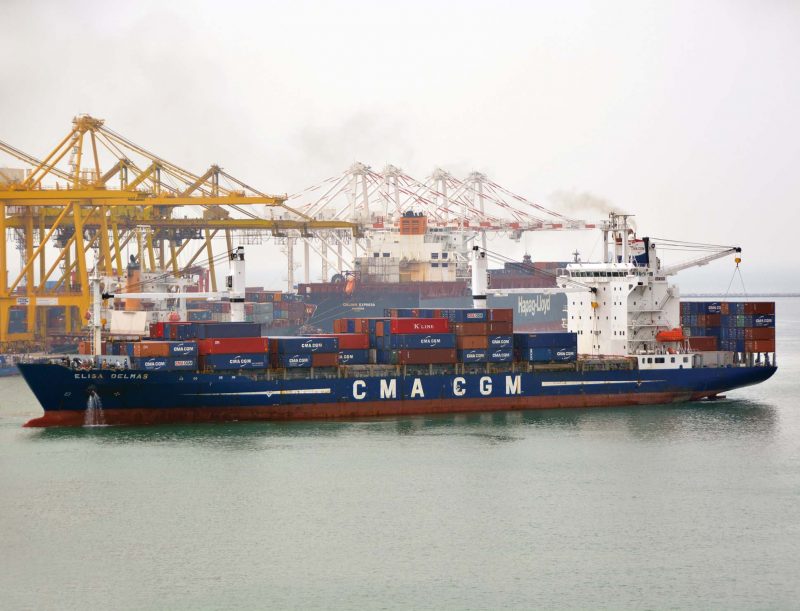

Delmas Finale
As from 1st March 2016, all CMA-CGM maritime activities to and from Africa were brought under one brand, that of CMA-CGM, after ten years with the Delmas and CMA-CGM brands running alongside each other. The Delmas fleet was absorbed into that of CMA-CGM, but the service provided to Delmas customers was not affected, with the African shipping and inland services maintained and developed. The Delmas accounting systems were progressively transferred into CMA-CGM computer systems, and the Delmas headquarters office at Le Havre sold off and the staff transferred to CMA-CGM. The CMA-CGM fleet running to Africa included four sister container ships of 3,650 TEU capacity including 500 reefer TEU, built in 2010 at Subic Bay in the Philippines, and named CMA-CGM Africa One, CMA-CGM Africa Two, CMA-CGM Africa Three and CMA-CGM Africa Four. This rebranding of Delmas African services came just one year short of Delmas celebrating a magnificent 150 years in shipping.
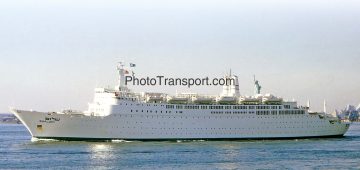
Comments
Sorry, comments are closed for this item